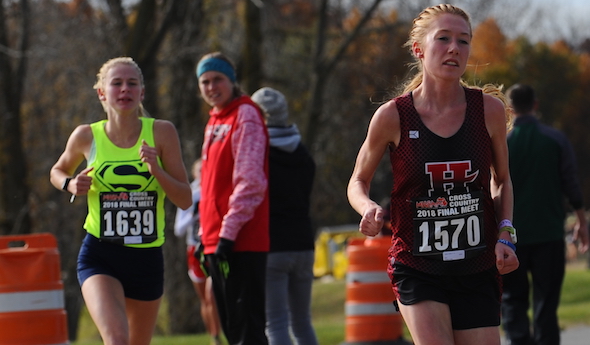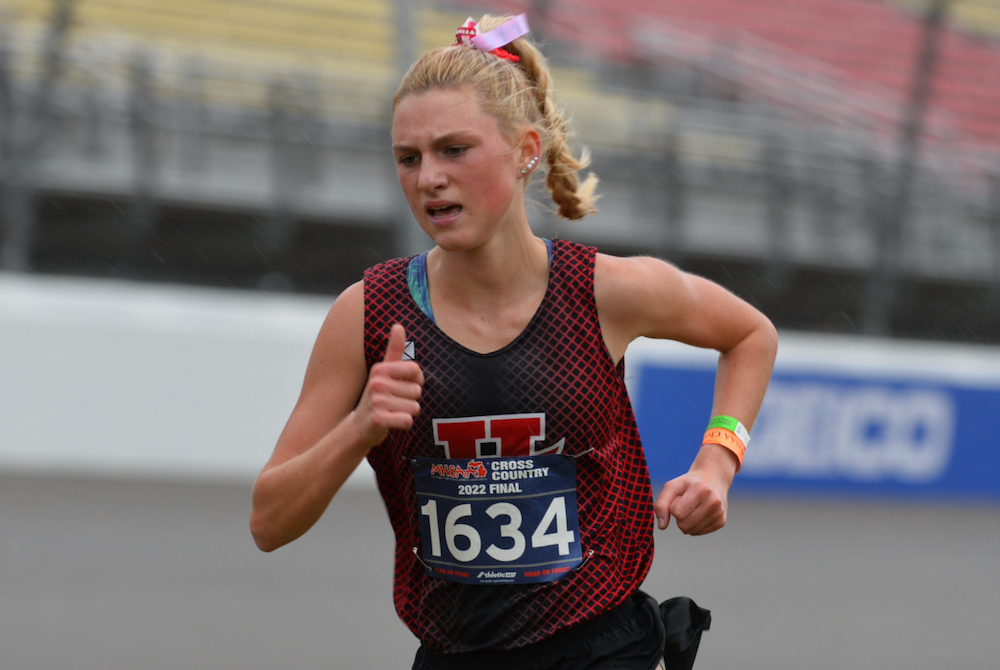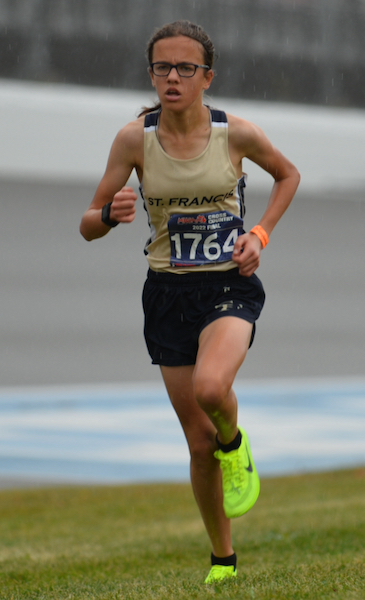
Hart, Ackley Complete Another Title Charge
November 3, 2018
Second Half reports
BROOKLYN — Shepherd’s Amber Gall set the bar for Hart’s Adelyn Ackley back in middle school.
It was the desire to beat Gall, whose times caught her attention, that drove Ackley to start training seriously back then.
“I raced her in eighth grade once at the MEGASTAR meet,” Ackley said. “When we were both in eighth grade, we raced the 3,200. My dad and I trained over the winter so we could race her, because we saw her time and she was really good. That’s how I got into running, too. She got me into running.”
Ackley and Gall put on a show that day as eighth-graders in the 2015 Mid Michigan MEGASTAR Meet at Shepherd, running times that would’ve been phenomenal for most high school athletes. Ackley edged Gall by half a second with a time of 11:02.37.
 They’ve continued to race in close proximity to one another through high school. In their final cross country meets in their school uniforms, Ackley held off a strong challenge from Gall to win her third MHSAA Division 3 individual championship in 17:42.8 on Saturday at Michigan International Speedway. Gall was second in 17:53.6. The rest of the field was 47 seconds back.
They’ve continued to race in close proximity to one another through high school. In their final cross country meets in their school uniforms, Ackley held off a strong challenge from Gall to win her third MHSAA Division 3 individual championship in 17:42.8 on Saturday at Michigan International Speedway. Gall was second in 17:53.6. The rest of the field was 47 seconds back.
“Amber Gall was right on my tail right up until the two-and-a-quarter-mile mark,” Ackley said. “I slowly pulled away once we got on the track. I was hoping to make a move after the mile or after the mile-and-a-half. I tried to make a move there. I did, and she hung on. I made another move once we got on the track, and I broke her there.”
Gall has finished second to Ackley the last two years, though her time Saturday brought her considerably closer than in 2017, when the gap was 26.8 seconds. In 2016, Ackley was first and Gall took fifth. In 2015, Ackley was second and Gall was third.
With two Ackley sisters and a cousin in its top four, Hart repeated as team champion with 43 points, beating Grandville Calvin Christian by 100. Hart had its five scoring runners across the line before Calvin Christian’s top runner finished.
Sophomore Savannah Ackley was seventh in 19:15.1, freshman Audrianna Enns was 10th in 19:26.8, sophomore Lynae Ackley was 13th in 19:31.8 and sophomore MacKenzie Stitt was 14th in 19:34.2 for Hart.
PHOTOS: (Top) Hart’s Adelyn Ackley stays a few paces ahead of Shepherd’s Amber Gall during Saturday’s Division 3 Final. (Middle) Hart’s Savannah Ackley approaches the finish line on the way to placing seventh. (Click for more from RunMichigan.com.)

Jazwinski Brings Hart Individual Title as St. Francis Moves to Front of Team Pack
November 5, 2022
BROOKLYN – Cross country races can be won between the ears before runners ever step foot onto the course.
Attitudes were tested as rain began to descend on Michigan International Speedway and the wind picked up just before the start of the MHSAA Lower Peninsula Division 3 girls race late Saturday morning.
Hart sophomore Jessica Jazwinski was loving life as she prepared to race.
“As a distance runner, I really try to love the wind,” she said. “Distance running and cross country is just a tough sport. The wind just adds to it — and the rain, too. It’s super fun.
“I was just thinking these conditions are just gonna feed my great race. This is real cross country. Yeah!”
Jazwinski overcame the elements to run the fifth-fastest Division 3 time ever, winning with a time of 17:36.70. She has two of the top-five times in Division 3 Finals history, having run 17:31.4 to place third last year.
“Today my race plan was just to go out hard and try to hold on to my pace,” she said. “I feel like I tried to race a lot like Steve Prefontaine, just go out and hold on.”
 Lansing Catholic senior Hannah Pricco was second in 18:17.59, Onsted sophomore Emmry Ross was third in 18:20.96 and Hart junior Alyson Ens was fourth in 18:28.52.
Lansing Catholic senior Hannah Pricco was second in 18:17.59, Onsted sophomore Emmry Ross was third in 18:20.96 and Hart junior Alyson Ens was fourth in 18:28.52.
“I love having great teammates to work with and encourage each other,” Jazwinski said. “We really try to encourage each other so much throughout the races. Throughout this year, some races she’s been a minute behind me, some races she’s been five seconds. I don’t want her to ever beat me, so that pushes me so much. I know she’s trying to race me and get up there with me.”
The only downer for Hart was having its string of Division 3 championships end at five with a fourth-place finish. Hart had two runners in the top four, but its No. 3 runner was 68th.
“I would totally trade my individual title for a team title,” Jazwinski said.
Traverse City St. Francis emerged from a close battle to win its first title since 2016 with 134 points. Pewamo-Westphalia was second with 142 and Lansing Catholic third with 165.
Sophomore Betsy Skendzel led St. Francis, placing seventh in 18:48.33. Completing the team score were senior Sophia Rhein in 26th (19:43.27), sophomore Grace Slocum in 33rd (20:07.95), junior Rylee Duffing in 60th (20:44.82) and junior Margot Hagerty in 63rd (20:45.78).
Lansing Catholic had three place in the top 10, but didn’t get another finisher until 103rd.
PHOTOS (Top) Hart’s Jessica Jazwinski pushes toward the finish during Saturday’s LPD3 Final. (Middle) Traverse City St. Francis’ Betsy Skendzel leads the way for the eventual team champion. (Click for more from Dave McCauley/RunMichigan.com.)

